AI Thought Leadership: The Minds Shaping the Future [2024 Trends + Examples]
- Home
- Intelligent Insights Blog
- AI Thought Leadership: The Minds Shaping the Future [2024 Trends + Examples]
Artificial Intelligence (AI) has gone from a futuristic concept to a revolutionary force as it continues to shape various aspects of our lives.
At the forefront of this revolution are AI thought leaders. They drive innovation, research, and discussions in the field.
Beyond technical expertise, AI thought leaders offer insights into ethical considerations, societal impacts, and strategic applications. They are pioneers who navigate the complex intersections of innovation, policy, and human collaboration.
From envisioning groundbreaking advancements to addressing the ethical challenges that accompany AI, these thought leaders play a pivotal role in shaping the trajectory of this transformative technology.
In this article, we’ll check out the key figures, organizations, publications, and podcasts that exemplify AI thought leadership.
We’ll also explore the anticipated trends in AI for 2024.
Here’s the list of what we’ve included:
- What is AI Thought Leadership?
- Anticipated AI Trends in 2024 + Examples
- Additional AI Thought Leadership Resources
Ready to start your journey as an AI thought leader?
Not sure where to start? Let us help. Book a free consultation with one of our AI PR experts and we will help you get started on or improve your AI thought leadership strategy.
What is AI Thought Leadership?
AI thought leadership refers to the position of influence and authority that individuals or organizations hold in the field of artificial intelligence (AI). Those who are considered AI thought leaders are often recognized for their expertise, innovative ideas, and contributions to the advancement of AI technology and its applications.
AI Thought Leadership Activities
- Research and Innovation: AI thought leaders contribute to groundbreaking research in AI, develop new algorithms, and advance the understanding of AI concepts.
- Public Speaking and Conferences: Thought leaders in AI participate as speakers or panelists at conferences, seminars, and events to share insights, discuss trends, and educate others in the AI community.
- Writing and Publications: They publish articles, books, or whitepapers on AI topics to share knowledge, perspectives, and predictions about the future of AI.
- Industry Influence: AI thought leaders play a key role in shaping the direction of AI within industries by advising companies, governments, and organizations on AI strategies and implementations.
- Community Engagement: Thought leaders in AI actively participate in AI communities, forums, and online discussions to share expertise, answer questions, and foster collaboration.
- Education and Training: They provide educational resources, training programs, or mentorship to help others develop their skills in AI.
AI thought leaders are often recognized for their ability to anticipate trends, guide discussions, and influence the broader AI landscape.
This leadership role can be held by researchers, entrepreneurs, academics, and professionals who have demonstrated a deep understanding of AI and its potential impact on society.
For more information on the power of thought leadership, check out our article: Unlocking the Power of Thought Leadership Marketing (Benefits + Best Practices)
Anticipated AI Trends in 2024 + Examples
Staying ahead of the AI curve requires more than just technological prowess — it demands a keen understanding of the prevailing thought leadership trends. As AI continues to evolve at an unprecedented pace, AI thought leaders play a pivotal role in shaping its trajectory.
Let’s check out some anticipated trends in 2024 and who to follow in these areas of advancement.
1. AI in Healthcare
AI integration into healthcare is revolutionizing the medical landscape. By leveraging the latest in algorithms and machine learning, AI facilitates:
- Quicker Diagnosis
- Personalized Treatment Plans
- Predictive Analytics
Medical professionals benefit from enhanced decision support systems, improving accuracy and efficiency. AI-driven technologies enable the analysis of vast datasets to identify patterns that may go unnoticed by humans, while virtual health assistants and chatbots streamline patient communication and provide instant information and support.
While there are still ethical considerations, data privacy, and the need for regulatory frameworks pose challenges, AI continues to evolve. Its integration holds immense potential to enhance patient outcomes, optimize workflows, and shape the future of healthcare.
Example of an AI Healthcare Thought Leader – Dr. Fei-Fei Li
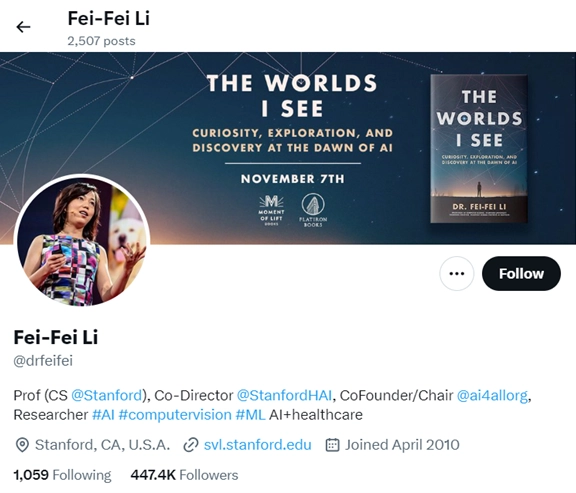
Dr. Fei-Fei Li is a prominent figure in the AI field who has significantly contributed to the integration of AI into healthcare. As the co-director of the Stanford Institute for Human-Centered AI (HAI), she has spearheaded research initiatives aimed at harnessing AI’s power to transform healthcare delivery.
Dr. Li’s work focuses on developing innovative solutions to address healthcare challenges, leveraging machine learning for medical imaging analysis and diagnostics. Her research has led to the creation of AI algorithms capable of interpreting complex medical images that aid clinicians in early disease detection.
She is also committed to ethical AI practices, emphasizing the importance of transparency and accountability in healthcare AI applications. Through her AI thought leadership, Dr. Li advocates for interdisciplinary collaboration, bringing together experts from AI, medicine, and policy-making to ensure the responsible integration of AI technologies in healthcare settings.
Are you in the healthcare field? For more on healthcare thought leadership, check out our article: 8 Step Guide to Innovative Healthcare Thought Leadership [+ 6 Trends]
2. AI for Climate Change Solutions
AI presents a transformative approach to addressing environmental challenges. Through advanced algorithms and data analytics, AI optimizes resource management and offers valuable insights into:
- Climate Patterns
- Deforestation
- Pollution
Machine learning models enhance predictive capabilities, aiding in the development of resilient strategies for climate adaptation. AI also plays a crucial role in renewable energy optimization, which maximizes efficiency and reduces carbon footprints.
Though data accessibility and the need for global collaboration still pose hurdles, advancements in AI remain a reassuring e-brake as we near the precipitous climate cliff. AI integration into climate change initiatives holds promise for sustainable solutions and a greener, more resilient future.
Example of an AI Climate Change Thought Leader – Andrew Ng
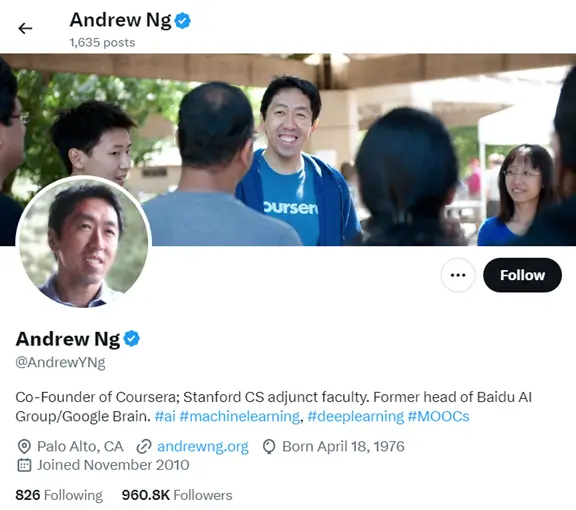
Andrew Ng is an AI thought leader who has made substantial contributions to integrating AI into climate change solutions.
As the co-founder of Google Brain and the founder of DeepLearning.AI, Ng has emphasized the pivotal role of AI in addressing environmental challenges.
His work involves leveraging machine learning to analyze extensive sets of data related to climate patterns, deforestation, and carbon emissions. Through initiatives like the AI for Earth program, Ng advocates for the use of AI to drive sustainability efforts.
He promotes the development of predictive models that enhance climate change understanding and aid in the formulation of effective mitigation strategies. Ng’s AI thought leadership also extends to education, as he strives to empower a new generation of AI practitioners to apply their skills to tackle climate issues.
Are you in the renewable energy sector? Then you might want to check out our article: 12 Examples of Renewable Energy Thought Leadership 2024
3. AI in Edge Computing
AI integration into edge computing marks a paradigm shift in data processing and decision-making. By deploying machine learning algorithms directly on edge devices, such as sensors and IoT devices, AI enables real-time analysis and responses without relying heavily on centralized cloud servers.
This decentralized approach:
- Minimizes Latency
- Enhances Privacy
- Reduces Bandwidth Usage
Edge AI finds applications in diverse fields, from autonomous vehicles to smart cities. However, challenges like limited computational resources and security concerns need careful consideration. As AI capabilities expand, the synergy with edge computing promises a more efficient, responsive, and scalable infrastructure for a wide array of applications.
Example of an AI Edge Computing Thought Leader – Fay Arjomandi

Fay Arjomandi is the founder, president, and CEO of mimik — a hybrid edge cloud (HEC) computing platform. She’s a trailblazer in integrating AI into edge computing, revolutionizing the intersection of these two cutting-edge technologies.
As a visionary entrepreneur and technologist, Arjomandi has played a pivotal role in shaping the landscape of edge computing by leveraging AI to enhance efficiency and capabilities.
Her notable AI thought leadership contributions include spearheading partnership work that bridges the gap between AI algorithms and edge devices, enabling real-time processing and decision-making at the edge of networks.
Arjomandi’s innovative approaches have not only optimized computational resources but have also unlocked new possibilities for applications such as IoT, autonomous systems, and smart cities. Her AI thought leadership continues to drive the seamless integration of AI into edge computing and shape a future where decentralized intelligence empowers diverse industries.
4. Natural Language Processing (NLP) Advancements
The seamless integration of AI into NLP has revolutionized the way machines understand and interact with human language. NLP, a subfield of AI, focuses on the interaction between computers and human language. It enables machines to comprehend, interpret, and generate human-like text.
Through advanced algorithms and machine learning models, AI enhances NLP by improving:
- Language Understanding
- Sentiment Analysis
- Context Comprehension
This integration empowers applications ranging from virtual assistants and chatbots to language translation services, unlocking new frontiers in communication, accessibility, and automation. The synergy between AI and NLP continues to reshape how we communicate and engage with technology.
Example of an AI NLP Thought Leader – OpenAI
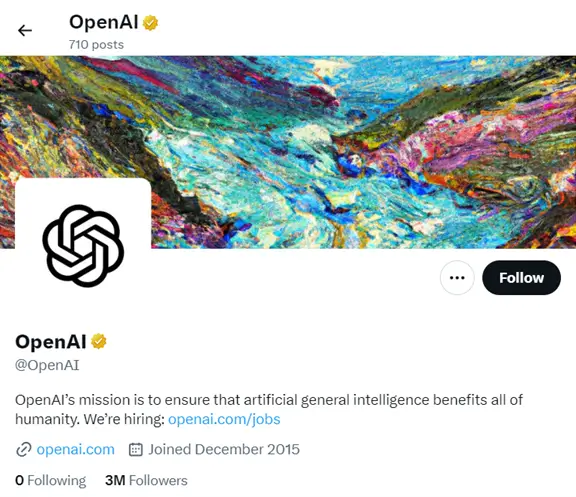
OpenAI remains at the forefront of advancing AI integration into NLP, driving breakthroughs in the field. The organization’s commitment to developing cutting-edge models, such as GPT-4 Turbo and GPT-4 Vision, has elevated NLP and visual capabilities to unprecedented levels.
GPT-4 Turbo, a language model with a 128k context window, showcases OpenAI’s dedication to pushing the boundaries of AI-powered language understanding and generation. Their research and development initiatives have significantly influenced the integration of AI into diverse NLP applications, from chatbots to content generation.
OpenAI also champions the democratization of AI technologies to cultivate accessibility and collaboration in the AI community. Through open-sourcing key projects and initiatives, OpenAI encourages widespread participation that fuels innovation in AI integration.
If you’re in the tech sector, you might want to consider tech thought leadership. Learn more here: Technology Thought Leadership: Shaping the Digital Landscape [+ 16 Examples]
5. Ethical AI and Responsible AI Practice
The burgeoning integration of AI has underscored the critical need for ethical considerations and responsible practices.
The UNESCO Global Forum on the Ethics of AI 2024 will be held February 5-6 in Slovenia as a growing emphasis is placed on addressing biases, ensuring transparency, and upholding fairness in AI systems.
As AI applications become pervasive, concerns about unintended biases in algorithms have prompted a shift towards responsible AI development. Stakeholders are actively engaged in defining guidelines and standards to mitigate ethical challenges.
Transparency in AI decision-making processes and a commitment to fairness are pivotal to building trust and ensuring the responsible deployment of AI technologies.
This evolving landscape signals a collective commitment to navigating the ethical dimensions of AI integration through 2024.
Example of an Ethical AI Thought Leader – Timnit Gebru

Timnit Gebru, founder and executive director at The Distributed AI Research Institute (DAIR), is a leading AI researcher who has significantly influenced discussions on ethical AI and fairness within machine learning models.
As a co-author of the influential Gender Shades research project, Gebru shed light on the biases embedded in facial recognition systems, prompting a reevaluation of these technologies.
Her groundbreaking work extends to issues of diversity, inclusion, and responsible AI development. Gebru’s co-founding of the group Black in AI and her advocacy for underrepresented voices underscore her commitment to fostering diversity in the AI community.
Notably, Gebru’s tenure at Google Research was marked by her outspoken stance on ethical concerns. Her departure from Google in 2020 sparked widespread conversations about the challenges researchers face in navigating corporate environments while advocating for ethical AI.
Gebru’s AI thought leadership continues to shape the discourse around fairness, transparency, and accountability in machine learning as she emphasizes the imperative of considering societal impacts in AI development.
AI-Enhanced PR: Transforming Public Relations in 2024
The seamless integration of AI into PR strategies is a notable trend reshaping the PR landscape in 2024. This transformative union brings forth innovative approaches to:
- Communication
- Relationship Building
- Reputation Management
- Stakeholder Engagement
As organizations recognize the power of AI in analyzing vast amounts of data and predicting trends, AI-integrated PR emerges as a strategic imperative.
Preston’s AI-enhanced PR platform by Intelligent Relations elevates the efficiency of communication and PR campaigns and augments decision-making processes to create a more data-driven and adaptive PR ecosystem.
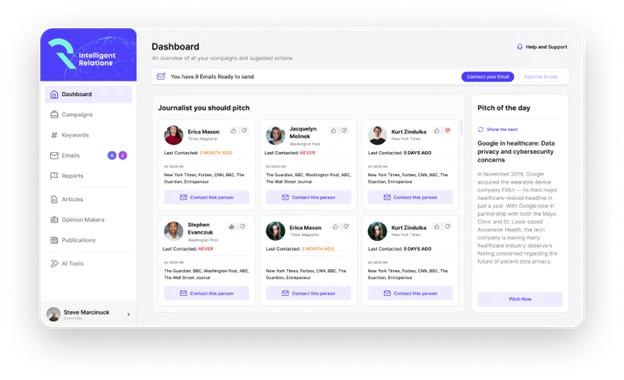
With the understanding that PR is traditionally a “slow-to-adapt and labor-intensive field,” Intelligent Relations co-founder and general manager Steve Marcinuk recognized early that AI integration “streamlines the time-consuming aspects of PR, such as identifying relevant journalists, drafting content, and managing media relationships.”
This tech prescience was parlayed into a powerful AI-enhanced PR platform that amplifies results and modernizes workflow.
In essence, the integration of AI in PR marks a significant shift toward a more agile, data-driven, and efficient approach — one that ultimately strengthens the industry’s adaptability in the rapidly changing media landscape.
Key Aspects of AI-Integrated PR in 2024
- Data-Driven Insights: Advanced analytics and machine learning algorithms enable PR professionals to extract meaningful insights from diverse datasets. AI assists in monitoring media trends, sentiment analysis, and predicting public reactions, providing valuable inputs for crafting targeted and resonant communication strategies.
- Personalized Communication: AI algorithms facilitate the customization of communication content based on individual preferences, demographics, and online behavior. This level of personalization enhances audience engagement and ensures that PR messages resonate effectively with diverse target groups.
- Crisis Management and Reputation Enhancement: AI technologies play a crucial role in the early detection of potential crises, analyzing public sentiment during sensitive situations, and providing real-time recommendations for effective crisis communication. Additionally, AI aids in proactively managing and enhancing organizational reputation through continuous monitoring and adaptive strategies.
- Automation for Efficiency: Automation of routine PR tasks, such as content distribution, social media management, and report generation, frees up valuable time for PR professionals to focus on strategic planning and relationship building. AI-driven automation enhances overall efficiency and allows for a more streamlined PR workflow.
Key Takeaway: As AI continues to evolve, its integration into PR practices is poised to redefine how organizations:
- Communicate
- Manage Their Reputation
- Engage with Their Audiences
Embracing AI-integrated PR in 2024 becomes not only a strategic choice but a necessity for staying competitive in an increasingly dynamic and data-driven communication landscape.
Pro Tip: Find AI-powered tools that allow you to efficiently manage things like social listening, audience segmentation, and brand mentions. Using a tool like Preston allows you to find and build relationships with the most relevant journalists, track campaigns, track media mentions, find trends, find the most relevant publications, and create innovative media pitches.
Want to get the most from your PR strategy? Consider a thought leadership strategy: Thought Leadership Strategy: 14 Steps to Balancing Authority and Authenticity (+ Examples)
Additional AI Thought Leadership Resources
Thought leadership isn’t always a solo endeavor — collaborative efforts within organizations, publications, and podcasts often result in them becoming expert, authoritative entities in their industries. Here are some examples and additional AI thought leadership resources to follow.
Allen Institute for Artificial Intelligence (AI2)
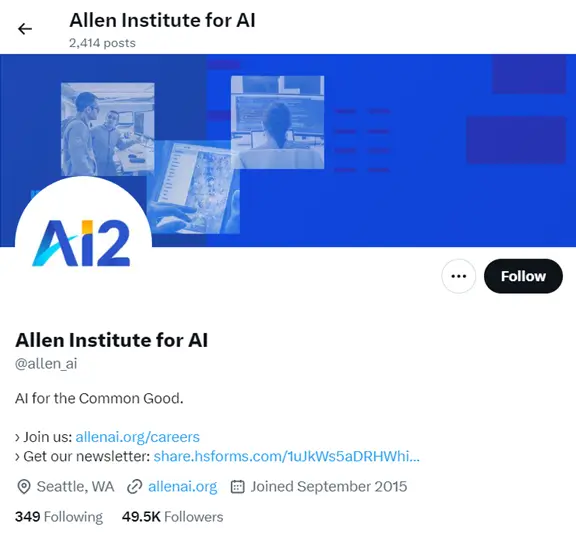
The Allen Institute for Artificial Intelligence (AI2) is at the forefront of AI thought leadership, spearheading transformative contributions to the field.
Founded by the late Microsoft co-founder Paul Allen, AI2 is renowned for its dedication to advancing artificial intelligence in a way that benefits humanity.
The non-profit institute excels in cutting-edge research that drives innovation and impactful initiatives. AI2’s commitment to open science is evident through its release of influential datasets and models, propelling collaborative efforts across the global AI community.
By actively engaging in interdisciplinary collaborations, AI2 plays a pivotal role in shaping the discourse on AI ethics, responsible AI development, and the societal implications of AI.
As a hub for top-tier researchers, AI2 continues to shape the future of AI through its thought-provoking contributions that set new standards and inspire advancements in the dynamic AI landscape.
Nature Machine Intelligence

Nature Machine Intelligence, a peer-reviewed AI and machine learning online journal, is a prominent publication in the realm of AI thought leadership and significantly impacts the field through its reputable contributions.
As a premier scientific journal, Nature Machine Intelligence serves as a platform for groundbreaking research and insights at the intersection of artificial intelligence and machine learning.
The chief editor, Liesbeth Venema, is dedicated to showcasing thought-provoking articles, reviews, and perspectives, providing a comprehensive overview of the latest advancements in AI.
Nature Machine Intelligence has played a pivotal role in shaping the discourse on key AI topics, from novel algorithms to ethical considerations and the societal implications of intelligent systems.
By publishing cutting-edge research from leading experts, the journal actively contributes to the intellectual foundation of AI and continues to be a driving force in advancing AI thought leadership.
In Machines We Trust

Produced by MIT Technology Review, In Machines We Trust is a prominent podcast in AI thought leadership. It offers a captivating exploration of the complex intersections between artificial intelligence and society.
Host and executive producer, Jennifer Strong, delves into the ethical, social, and philosophical dimensions of AI, unraveling its impact on our daily lives.
Through in-depth interviews with leading experts, researchers, and thought leaders, In Machines We Trust provides a nuanced perspective on the challenges and opportunities presented by intelligent systems.
The podcast not only disseminates crucial insights into cutting-edge AI developments but also bolsters a broader understanding of the ethical considerations surrounding AI adoption.
By bridging the gap between technical intricacies and societal implications, In Machines We Trust stands as a thought-provoking platform that actively contributes to shaping public discourse on the responsible and ethical use of artificial intelligence.
Want to appear on a podcast as an AI thought leader? Not sure where to start? Learn more here: How to Pitch a Podcast in 2024 [+ Real Examples]
Get AI-Empowered Today!
The world of AI thought leadership is vibrant and diverse, with key figures, publications, organizations, and podcasts driving the discourse forward. As we navigate the anticipated trends in 2024, it’s evident that AI will continue to impact industries and society at large, prompting a collective responsibility to ensure its ethical and responsible development.
It’s important to keep in mind that the journey into the future of AI is not just about technological advancements but also about the thoughtful and ethical guidance provided by the leaders in the field.
As we gaze into 2024, AI thought leadership is marked by trends in:
- Healthcare
- Responsible Practices
- Creative Collaboration
- Edge Computing
- Evolving Regulations
The fusion of technological prowess and ethical stewardship defines this era. It underscores the profound impact thought leaders have on steering the course toward a future where AI enhances our lives with wisdom, responsibility, and boundless possibilities.
Are you interested in taking your AI thought leadership to the next level? Let us help! Simply book a free consultation and our AI PR experts will show you how you can use AI to upgrade your strategy.

